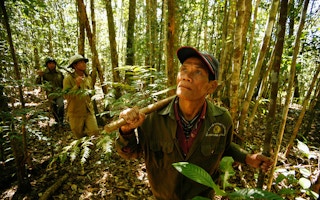Converting forests into farms is not economically viable except in selected regions, says a global study.
Published last month (July) in PLoS Biology, the study by researchers from the National University of Singapore (NUS) examined deforestation in more than 50 countries in the tropics between 2000—2012, and identified regions where deforestation is most and least beneficial.
According to Luis Roman Carrasco, lead author of the study and assistant professor at the NUS faculty of science, the study was undertaken “to help policymakers realise whether their deforestation strategies made economic sense and how these could be modified to avoid inefficient loss of natural resources.”
Areas where benefits from agricultural conversion are higher than cost of deforestation were identified as the Atlantic Forest (mostly coastal Brazil), the Gulf of Guinea and Thailand. These areas have high potential yields, low production costs, high prices for the produce and have market accessibility to trade centres such as cities.
In contrast, deforestation in Latin America, insular Southeast Asia (which include Brunei, Indonesia, Malaysia, the Philippines, Singapore and Timor Leste) and Madagascar derived low agricultural benefits and high environmental costs.
“
If you consider biodiversity as well as carbon and ecosystem services, you’d probably tend not to favour much deforestation at all.
William Laurance, Centre for Tropical Environmental and Sustainability Science
The team analysed deforestation and crop distribution and studied the trade-offs between agricultural benefits, carbon emissions and losses of multiple ecosystem services, which are benefits obtained by people from ecosystems such as forests. These benefits include carbon sequestration, flood protection and water purification.
The findings show that while gains by agriculture are US$32 billion to US$53 billion per year, the environmental damage caused by tropical deforestation during this period amounts to future annual losses of US$107 billion to US$135 billion per year. On the whole, tropical deforestation generates large economic losses, Carrasco notes while also pointing out that subsequent erosion from conversion was not even factored into the analysis.
“Having created this global map of trade-offs between agriculture and the benefits provided by tropical forests, we will now be looking into integrating these maps with market models to understand how changes in land use could lead to changes in prices and affect consumers, and other indirect impacts on deforestation,” he says.
“We are hoping that governments realise that deforestation has large, unrecognised costs in the form of lost ecosystem services. Land use planning decisions that ignore these costs are bound to be inefficient and harmful for local communities and humanity as a whole,” Carrasco adds.
William Laurance, director of Australia’s Centre for Tropical Environmental and Sustainability Science, says that even in the absence of biodiversity values, “most tropical forest lands are worth more as intact forests than felled and converted into agriculture.”
Even the areas identified in the study as suitable for deforestation, Laurance notes, are full of critically endangered species. “If you consider biodiversity as well as carbon and ecosystem services, you’d probably tend not to favour much deforestation at all.”
David Edwards, senior lecturer in conservation science, University of Sheffield, UK, believes that agricultural enterprises tend to measure predicted profits against costs of land, taxes, labour and inputs. “But through deforestation, they also create negative externalities — costs incurred by society, not the company.”
“What is needed,” Edwards says, “is a step change in how food is produced across the tropics to prevent further deforestation and thus slow climate change, save biodiversity and continue the flow of ecosystem services that people require.”
This piece was produced by SciDev.Net’s Asia & Pacific desk.








